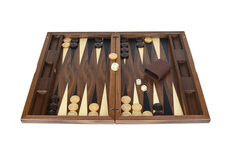Rules for Reversi and Othello
Rules of Reversi
Reversi is an abstract strategy board game invented during the Victorian era. It has remained popular for more than a century being given a boost in the 1970s when a version of it was re-marketed under the name 'Othello' and another in the 1990s when a computer version of it was included with the Microsoft Windows operating system. Reversi involves play by two parties on an eight-by-eight square grid with pieces that have two distinct sides. Pieces typically appear coin-like, with a light and a dark face, each side representing one player. The goal for each player is to make pieces of their colour constitute a majority of the pieces on the board at the end of the game, by turning over as many of their opponent's pieces as possible.
See also: Othello and Reversi.
Equipment
Reversi first appeared in Britain during the Victorian era and has been popular ever since. In the 1970s it was given a boost when a branded version of it called Othello became very popular and in the 1980's a version of the game appeared with the Microsoft Windows operating system which provided a further boon. Reversi is played upon an 8 x 8 squared board without chequers. Accompanying the board, there should be 64 pieces - originally each was red on one side and green on the other but of course any 2 colours can be used and more recently they tend to be dark and light.
Preparation and Objective
The board starts empty. Each player is allocated one of the colours by mutual agreement and they take turns to play a piece until all the squares are occupied. A player's objective is to have more of their allocated colour face upwards at the end of the game.
Basic Play
Player's toss a coin to decide who will play first. Each turn, the player places one piece on the board with their colour facing up.
For the first four moves, the players must play to one of the four squares in the middle of the board and no pieces are captured or reversed.
Each piece played must be laid adjacent to an opponent's piece so that the opponent's piece or a row of opponent's pieces is flanked by the new piece and another piece of the player's colour. All of the opponent's pieces between these two pieces are 'captured' and turned over to match the player's colour.
It can happen that a piece is played so that pieces or rows of pieces in more than one direction are trapped between the new piece played and other pieces of the same colour. In this case, all the pieces in all viable directions are turned over.
The game is over when neither player has a legal move (i.e. a move that captures at least one opposing piece) or when the board is full.
Othello ™
There are two differences between Othello™ and Reversi.
- In Othello, the two colours are Black and White and Black always plays first
- In Othello, the four squares in the middle of the board start with four counters already placed - white top left and bottom right; black top right and bottom left. The reason for this is that In Reversi, the extra freedom can result in an opening that produces a less interesting game.
- In Reversi if one player cannot not play a piece, the game finishes. In Othello, a player without a move simply passes, and the other player keeps playing pieces until the first player can make a move again.
These rules are provided by Masters Traditional Games, an Internet shop selling quality traditional games, pub games and unusual games. For general information or for copying and copyright, see our Rules Information page.
Our rules are comprehensive instructions for friendly play. If in doubt, always abide by locally-played or house rules.
Copyright James Masters, 2025. All rights reserved.


























